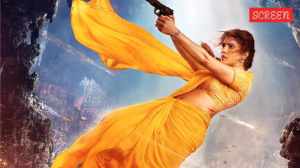A Life Unstrung
...

| Journey with a hundred strings By Shiv Kumar Sharma, with Ina Puri Viking, Rs 395 |
Let’s clarify up front that to look at a book on a musician is different from the respect and admiration one has for the musician himself. It’s well-established in the domain of public knowledge that santoor vidwan Pandit Shiv Kumar Sharma is the single, vital force behind the present popularity and esteem enjoyed by this “Kashmiri dulcimer”.
He had to struggle very hard indeed to gain credibility for his chosen instrument. Initially he could not play alap (raga exploration) on the santoor. He literally took it apart and reconstructed it, evolving its physical capabilities through intelligent risks. From the stand it was originally played on, he took it on his lap, to do away with unwanted vibrations. He swallowed insults, put up with poor pay and rude cultural organisers, supporting his wife and two sons in Bombay through film music. These are known facts about Panditji and part of post-Independence musical folklore.
When a book on such an important musician appears in the Viking India imprint, we do expect a work of quality to match the stature and personality of the artiste. What we’ve got, instead, is the proverbial curate’s egg, “good in parts”. Despite the valiant editing and the beautiful title, the book reads like a journey through a hundred cliches. Example: “As I disembarked from the crowded train and felt myself thrown into the chaotic whirlpool of humanity, the multitudes frantically rushing around Bombay Central Station that morning, my head spun as I took in the heat, dust, flies, beggars, passengers and vendors.”
Coming from the son of a rajpurohit, who himself studied “devabhasha” at college, the Sanskrit goochies are emb-
arrassing to read: Vasudeva kutum bakum instead of Vasudaiva kutumbakam — and Sam, Dam Dandavedh, not saam daan bhed dand (Chanakya’s prescribed steps for overcoming enemies).
Above all, Manjit Bawa’s drawings do not seem to add lustre to this book. Their earthy, swollen lines are not in consonance either with the delicate, spiritual voice of the santoor or with the gentle, introverted personality put across, of the book’s subject.
So, which are the “good” bits? The plain, actual facts, the tidbits we may not know. That Shivji’s first filmi sortie was in V. Shantaram’s Jhanak Jhanak Payal Baaje. Or that O.P. Nayyar rushed him in to play for Asha Bhonsle’s delicious hit Hazurewala jo ho ijazat. The snippets that musical folklore celebrates: Bade Ghulam Ali Khan’s favorite bhajan was Hari Om Tatsat. When the Pakistanis wouldn’t let him sing it, the ustad packed his bags for India.
It’s also interesting to read Shivji’s view: “Some sectors have criticised Jasrajji’s recent preference for singing only bhajans as representing the saffronisation of our culture. I personally feel that Jasrajji’s decision has more to do with his age and spiritual need.”
But such insights on musicians and music are few compared to the laborious detailing of supposedly “janranjak” trivia, in a fuzzy structure with many weak beginnings and endings.



- 01
- 02
- 03
- 04
- 05




























